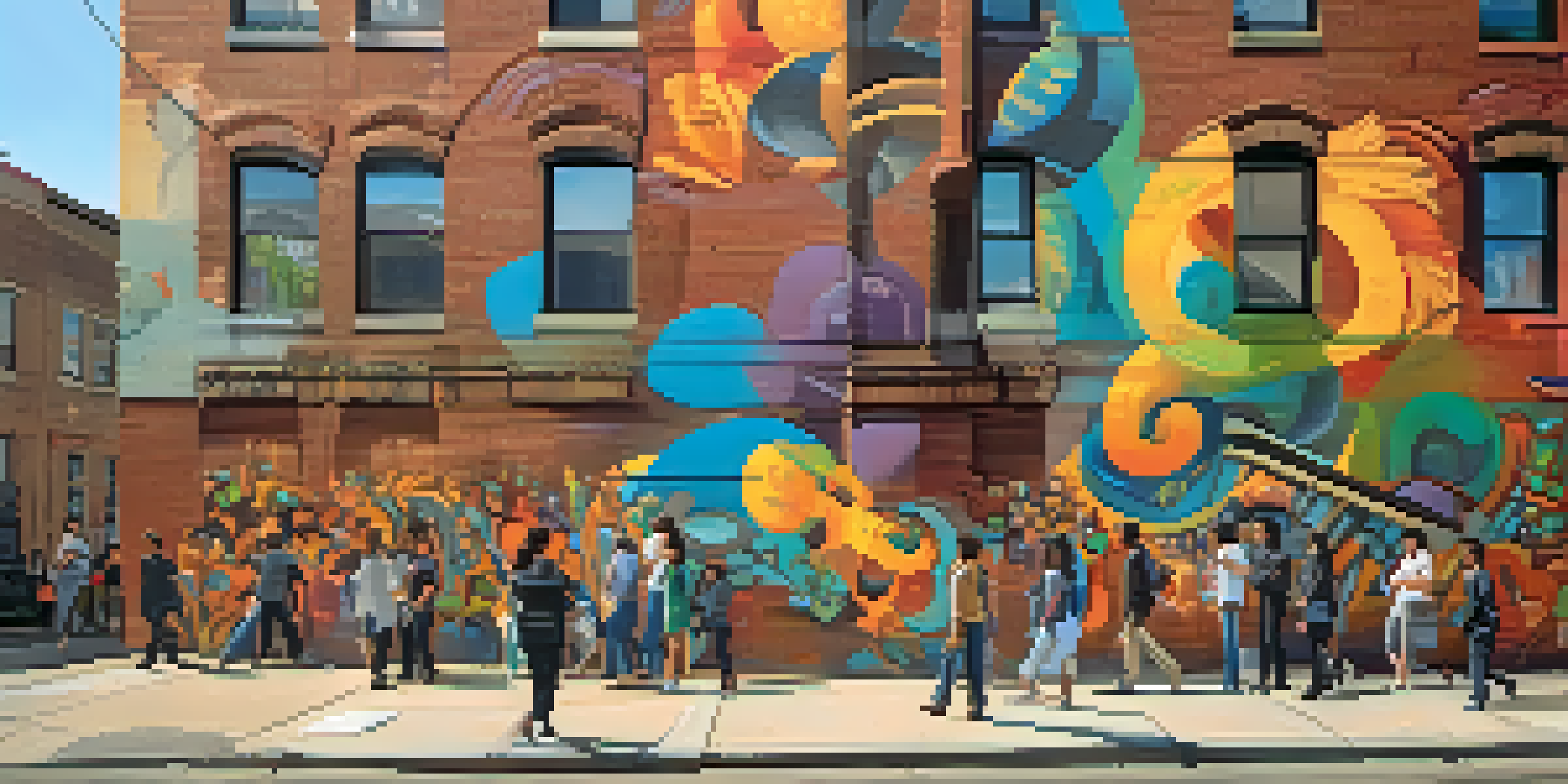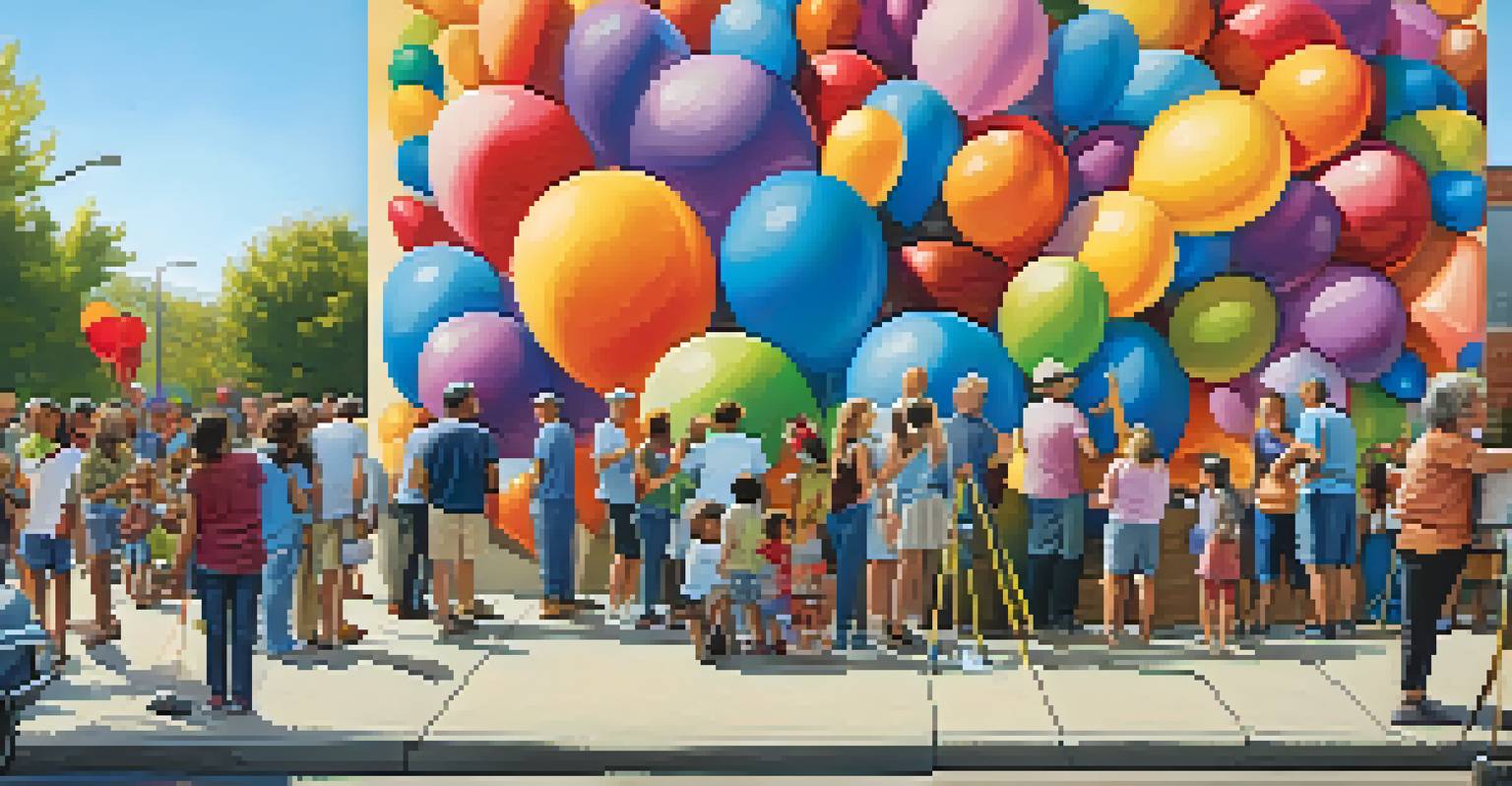Legal Perspectives: Street Art and Graffiti in Society

Defining Street Art and Graffiti: More Than Just Vandalism
Street art and graffiti often spark debate about their nature and purpose. While some view them purely as vandalism, others see them as forms of artistic expression. This distinction is crucial, as it influences how society perceives these works and, consequently, how laws apply to them.
Art is not a mirror held up to reality, but a hammer with which to shape it.
Graffiti typically refers to unwanted markings on property, while street art often encompasses more intentional, visually appealing works. However, the line between them can be blurry, leading to confusion over legality. For instance, a vibrant mural may be celebrated in one community but considered defacement in another.
This complexity prompts the question: should society embrace these forms of expression, or should stricter laws be enforced? Understanding the nuances of street art and graffiti is essential for navigating the legal implications surrounding them.
The Legal Framework: Copyright and Ownership Issues
One of the most significant legal aspects of street art and graffiti is copyright. Artists often create works without formal permission, leading to ownership disputes when their art is removed or altered. This raises the question of whether an artist retains rights to their work, even if it was created illegally.

In some cases, artists have successfully claimed copyright over their creations, even if they were painted on private property. This situation can create a legal gray area, where property owners may face consequences for removing or destroying artwork without the artist's consent. For example, the famous street artist Banksy has seen some of his works auctioned off for significant sums after being cut from walls.
Art vs. Vandalism Debate
The distinction between street art and graffiti influences societal perceptions and legal implications surrounding these forms of expression.
The intersection of copyright law and street art raises important considerations about artistic freedom and property rights. As society continues to evolve, so too must our understanding of these legal frameworks.
The Role of Consent in Street Art: A Double-Edged Sword
Consent is a critical factor in the legality of street art. When artists obtain permission from property owners, their work can be celebrated and protected. However, this often leads to debates about authenticity and the artist's original intent.
The essence of art is to be a reflection of the times we live in.
For instance, a mural commissioned by a business may not resonate with local communities as much as a spontaneous piece. This can create tension between the artist's vision and the expectations of those who funded the work. As a result, the line between art and commercialism can become blurred.
Navigating these dynamics requires sensitivity to community values and the artist's intent. The importance of consent cannot be overstated, as it shapes both the legal standing and cultural significance of street art.
Public Perception: Changing Attitudes Toward Street Art
Public perception plays a significant role in shaping the legal landscape of street art and graffiti. Over the years, many communities have shifted from viewing graffiti solely as vandalism to recognizing its artistic merit. This change often influences local policies and enforcement practices.
For example, cities like Melbourne and Berlin have embraced street art, designating specific areas for artists to showcase their work legally. This not only promotes creativity but also helps foster a sense of community ownership over public spaces. As a result, residents often take pride in their local street art scenes.
Copyright and Ownership Issues
The legal gray area surrounding copyright in street art raises important questions about artists' rights and property ownership.
This evolving perception highlights the importance of dialogue between artists, property owners, and local governments. By working together, communities can create environments that celebrate artistic expression while addressing legal concerns.
Street Art as a Political Tool: Legal Implications
Street art has long been used as a medium for political expression, often challenging societal norms and injustices. This can lead to clashes with authorities, as some governments may view political street art as a threat. The legal implications of such works can be particularly complex.
For instance, artists like Shepard Fairey have faced legal battles over their politically charged pieces. These cases often raise questions about freedom of speech and the extent to which governments can regulate art. The balance between protecting public property and upholding artistic expression is a delicate one.
Understanding the role of street art in political discourse is essential for grasping its legal ramifications. As artists continue to push boundaries, the legal system must adapt to ensure a fair balance between expression and regulation.
Enforcement Challenges: Balancing Art and Vandalism
One of the primary challenges in regulating street art is the difficulty of enforcement. Law enforcement agencies often struggle to distinguish between legitimate artistic expression and vandalism. This ambiguity can lead to inconsistent enforcement and confusion within communities.
For example, a city may crack down on graffiti in one neighborhood while celebrating murals in another. This inconsistency can frustrate both artists and residents, creating a sense of injustice. The lack of clear guidelines can further complicate matters, leaving artists uncertain about what is permissible.
Shifting Public Perceptions
Communities are increasingly recognizing street art's artistic merit, leading to more supportive policies and frameworks for artists.
Finding a balance between protecting property rights and fostering artistic expression is vital. Communities must engage in ongoing conversations to develop laws that reflect their values and support local artists.
Future Trends: The Evolving Legal Landscape of Street Art
As street art continues to gain recognition and popularity, the legal landscape surrounding it is likely to evolve. Emerging trends suggest a growing acceptance of street art as a legitimate form of expression, leading to potential changes in laws and regulations. This could pave the way for more inclusive policies that benefit both artists and property owners.
For instance, cities may adopt more comprehensive guidelines for street art, providing artists with clearer avenues for legal expression. This could reduce the stigma surrounding graffiti and promote a healthier dialogue about its role in society. Additionally, municipalities might explore artist-in-residence programs, allowing creators to contribute positively to urban spaces.

The future of street art and its legal implications remains uncertain, but one thing is clear: ongoing dialogue and collaboration between artists, communities, and lawmakers will be essential in shaping a more inclusive landscape.